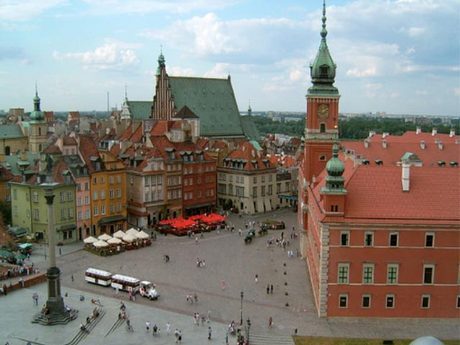Lodz
Lodz is one of the youngest, and one of the largest cities (near 800 000 of population) in Poland. The word Lodz means boat. The first information about Lodz is from the year 1332 about the village Lodzia (Latin), witch was the own of Kujawy's bishops.
In Poland village became town, when it gets formal document from a king and the owner of the village. In 1414 bishop of Włocławek - Jan Kropidłomake the document, and in the 1423 king Władysław Jagiełło gave the town rights to Lodz . First of all Lodz was a completely agricultural town (44 wooden houses and 44 barns) up until the 16th century when development of the town commenced. The population was 700 citizens. After that came a worse time for Lodz , and at the end of the 18th century there were only 170 citizens in 30 houses. At the same time the Jews had come to town, in the 20s of 19th century Germans' manufactories, and in the end of 19th century Russians. From this moment onwards Lodz became multinational and specific in this situation. In 19th century Lodz become the most important center of textile production. Lodz was the most specific city in Europe.
Łódź first appears in the written record in a 1332 document giving the village of Łodzia to the bishops of Włocławek. In 1423 King Władysław Jagiełło granted city rights to the village of Łódź. From then until the 18th century the town remained a small settlement on a trade route between Masovia and Silesia. In the 16th century the town had fewer than 800 inhabitants, mostly working on the nearby grain farms.
With the second partition of Poland in 1793, Łódź became part of the Kingdom of Prussia's province of South Prussia, and was known in German as Lodsch. In 1798 the Prussians nationalised the town, and it lost its status as a town of the bishops of Kuyavia. In 1806 Łódź joined the Napoleonic Duchy of Warsaw and in 1810 it had 190 inhabitants. In 1815 Congress of Vienna treaty it became part of Congress Poland, a client state of the Russian Empire.
In the 1815 treaty, it was planned to renew the dilapidated town and with the 1816 decree by the Czar a number of German immigrants received territory deeds for them to clear the land and to build factories and housing. In 1820 Stanisław Staszic aided in changing the small town into a modern industrial centre. The immigrants came to the Promised Land ( Ziemia obiecana, the city's nickname) from all over Europe. Mostly they arrived from Southern Germany, Silesia and Bohemia, but also from countries as far away as Portugal, England, France and Ireland. The first cotton mill opened in 1825, and 14 years later the first steam-powered factory in both Poland and Russia commenced operations. In 1839 the population was 80% Germans and German schools and churches were established.
A constant influx of workers, businessmen and craftsmen from all over Europe transformed Łódź into the main textile production centre of the Russian Empire. Three groups dominated the city's population and contributed the most to the city's development: Poles, Germans and Jews, who started to arrive since 1848. Many of the Łódź craftspeople were weavers from Silesia.
In 1850, Russia abolished the customs barrier between Congress Poland and Russia proper; industry in Łódź could now develop freely with a huge Russian market not far away. Soon the city became the second-largest city of Congress Poland. In 1865 the first railroad line opened (to Koluszki, branch line of the Warsaw-Vienna Railway), and soon the city had rail links with Warsaw and Białystok.
Łódź Władysław Reymont Airport, formerly known as Łódź-Lublinek Airport, is a regional airport in central Poland, located approximately 6 km (3.7 mi) southwest of the Łódź city center. The airport has been in operation since September 13th 1925 and has recently undergone a number of upgrades enabling it to handle services by low cost airlines to destinations in Europe. It has recently been named after the celebrated 20th century Polish writer and the winner of the 1924 Nobel Prize in Literature, Władysław Reymont. The main airline at the airport include Centralwings, Ryanair and Volareweb, with the most popular routes include Dublin, London and Nottingham, along with regular flights into Warsaw, which is particularly useful for those with onward flights.
The public transport system in Lodz is operated by the Miejskie Przedsiebiorstwo Komunikacyjne and includes a mixture of trams and buses, both of which share the same tickets and are a cheap way to travel around this large Polish city. Worth noting, tickets are validated as you board your transport and remain valid for a specific period of time, during which they can be used for unlimited travel on bus and tram lines all over Lodz.
Bicycle rickshaws are always a fun mode of transportation in Lodz and these regularly travel all along the Ulica Piotrkowska, for just a small charge. Rickshaws in Lodz are generally slightly more expensive by night and most drivers will be happy to transport passengers to other parts of the city, away from the Ulica Piotrkowska.




